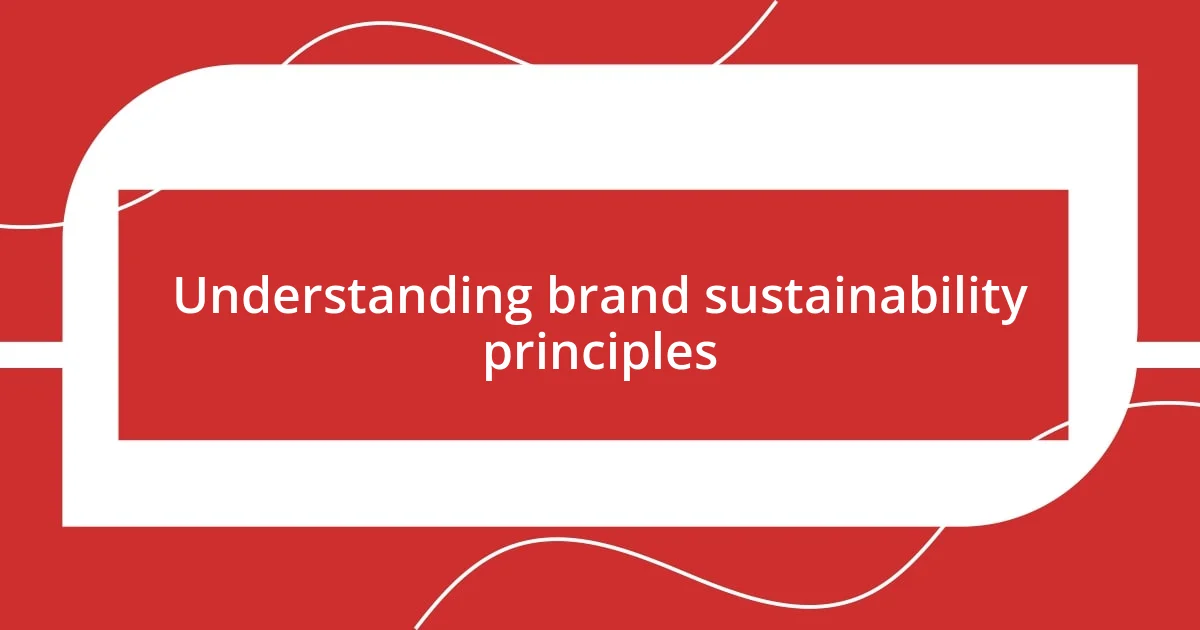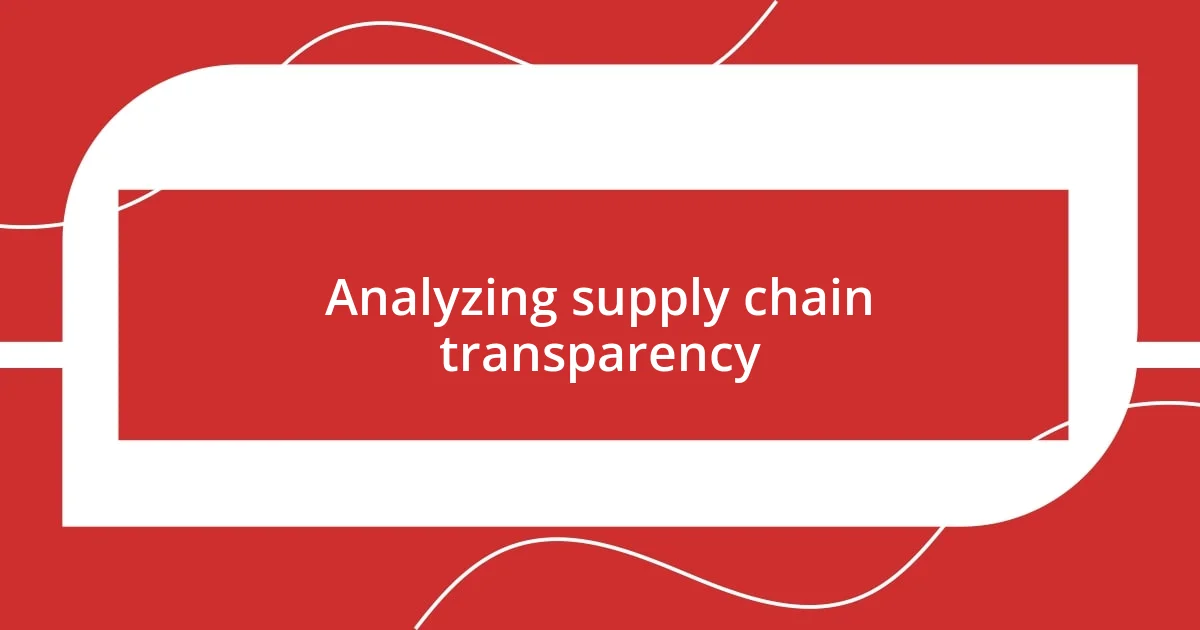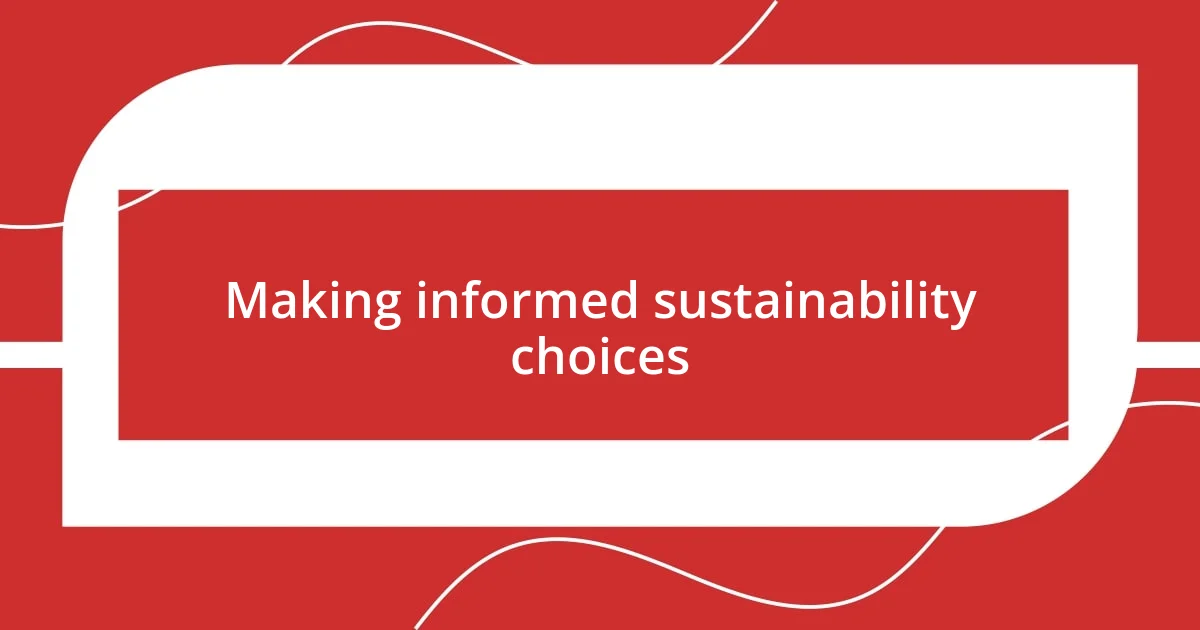Key takeaways:
- Sustainability encompasses ethical sourcing, social equity, and transparency, requiring continuous commitment rather than a one-time effort.
- Key indicators of sustainable brands include responsible labor practices, effective waste management, and transparency in supply chains, all of which shape consumer trust and brand loyalty.
- Engaging consumers in sustainability initiatives and measuring long-term goals are essential for brands to demonstrate accountability and foster meaningful community relationships.

Understanding brand sustainability principles
Understanding brand sustainability principles goes beyond just eco-friendly practices; it encompasses a holistic approach to business operations. For instance, when I started evaluating companies for their sustainability efforts, I was often surprised to discover that true sustainability is about ethical sourcing, community impact, and transparency. Have you ever wondered how deeply a brand is intertwined with the communities that enable its existence?
The intricate web of sustainability principles includes environmental stewardship, social equity, and economic viability. I vividly recall a moment when a company I admired shared the struggles it faced in maintaining ethical labor practices. Their candidness not only opened my eyes to the challenges but also highlighted the importance of proactive measures in supply chains. This made me realize that sustainability isn’t a tick-box exercise; it’s an ongoing commitment.
There’s a personal value in supporting brands that prioritize sustainability. When I choose to buy from a company that actively reduces its carbon footprint, it’s more than just a purchase; it’s a statement of my values. It makes me reflect, doesn’t it? Every dollar I spend has the potential to drive positive change, and understanding these principles empowers me to make informed choices that align with my beliefs.

Identifying sustainable practices in brands
To truly identify sustainable practices in brands, I look for their commitment to long-term goals and how they implement these in everyday operations. For instance, I remember purchasing from a local clothing brand that emphasized eco-friendly materials. When I learned that they utilized organic cotton and recycled fabrics, it felt rewarding, knowing my purchase was supporting responsible sourcing. Discovering that a brand actively engages in reducing waste and creating circular economy practices is crucial.
Here are some key sustainable practices to consider when evaluating brands:
- Ethical Labor Practices: Ensuring fair wages and safe working conditions for employees.
- Sourcing Materials Responsibly: Using renewable and biodegradable materials over harmful alternatives.
- Waste Minimization: Implementing recycling and upcycling methods in production.
- Transparency in Supply Chains: Clearly communicating where and how products are made.
- Community Engagement: Supporting local economies and giving back to the communities involved in production.
These elements make a brand’s commitment to sustainability tangible and meaningful, transforming the shopping experience into one that aligns with my values.

Analyzing supply chain transparency
Analyzing supply chain transparency is a crucial part of assessing brand sustainability. I find that brands willing to disclose the complexities of their supply chains showcase a level of honesty that resonates deeply with me as a consumer. For instance, I recall a time when I stumbled upon a company that not only detailed their sourcing practices but also shared the stories of the artisans involved. That transparency moved me; it transformed my purchase into an experience where I felt a genuine connection to the people behind the products.
When evaluating a brand’s supply chain transparency, I examine factors such as the traceability of materials and the clarity of their labor practices. I once came across a skincare brand that went above and beyond by providing an interactive map on their website, outlining the journey of their ingredients from source to shelf. This level of detail not only satisfied my curiosity but also reinforced my trust in their commitment to ethical sourcing. It made me wonder—how would my purchasing choices change if more brands embraced this level of transparency?
To further dissect supply chain transparency, I consider how brands communicate their partnerships with suppliers and the standards they uphold throughout the supply chain. I remember feeling a sense of reassurance the day I learned that my favorite coffee brand practices fair trade and has strict guidelines for its suppliers. It was as if I was handed a behind-the-scenes pass to a world where ethics and quality coalesce, enhancing my appreciation of their product.
| Criteria | Indicators of Transparency |
|---|---|
| Material Traceability | Clear documentation of sources, including certification of sustainable practices. |
| Labor Practices | Detailed policies on worker treatment, wages, and safety measures. |
| Supplier Relationships | Open communication about partnerships and shared values. |
| Ethical Certifications | Certifications from recognized sustainability organizations. |

Evaluating environmental impact measures
Evaluating a brand’s environmental impact measures involves examining their efforts to minimize ecological footprints. One brand that particularly caught my attention was a startup focused on sustainable packaging. Their commitment was evident in using biodegradable materials and adopting a reduced-waste strategy. I remember unboxing their products and feeling content knowing that my choice contributed to less landfill waste. Have you ever felt that rush when discovering a brand genuinely cares for the planet?
When I assess environmental impact measures, I also delve into a brand’s carbon footprint reduction initiatives. I encountered a revolutionary outdoor gear company that not only calculated its emissions but actively worked to offset them through reforestation projects. Reading about their contributions to restoring ecosystems left me inspired. It’s incredible how knowing the positive impact of our purchases can transform our shopping habits, right?
Moreover, I pay close attention to the company’s adherence to environmental certifications. For instance, a pet food brand I trust proudly displayed its involvement in the Non-GMO Project and sought European Union Organic Certification. This commitment assured me that I was feeding my furry friend food that was not only high-quality but also sustainably sourced. When a brand wears its certifications like a badge of honor, it speaks volumes about its environmental dedication. Isn’t it reassuring to support brands that are transparent about their environmental impacts?

Assessing social responsibility initiatives
When I assess brands for their social responsibility initiatives, I pay close attention to their community engagement efforts. I recall my excitement when a local clothing brand launched a program where they donated a portion of their sales to support education for underprivileged youth. It made my heart swell to know my purchase was directly contributing to a cause bigger than myself. Can you recall a moment where your buying choice felt impactful?
I also look for brands that empower their employees through social programs. There was this remarkable cosmetics company that offered scholarships for staff looking to further their education. Learning about their commitment to personal development moved me; it made me view their products not just as items to buy but as a representation of values that resonate with my own. Isn’t it empowering to choose brands that invest in the growth of their people?
Furthermore, I appreciate brands that cultivate partnerships with local communities for sustainable development. I remember discovering a beverage company that sourced its ingredients from local farmers, providing fair wages and fostering better living conditions. Understanding that my choice helped support local economies and promote sustainability filled me with pride. It prompts me to question—how often do we consider the ripple effects of our purchases on communities at large?

Measuring long-term sustainability goals
Measuring long-term sustainability goals requires a keen eye for a brand’s commitment to continuous improvement. I recall a leading fashion brand proudly sharing its multi-year plan to achieve carbon neutrality by 2030. As I read their transparency report, I felt a sense of trust grow; here was a company that not only set ambitious goals but also outlined the specific steps they planned to take. Doesn’t it feel good to know there are brands out there willing to hold themselves accountable?
Another aspect I find crucial is how brands track their progress against these sustainability benchmarks. I recently learned about a tech company that publishes annual sustainability reports, detailing their successes and setbacks. Their candid approach reminded me of a mentor who once advised me that acknowledging areas for growth is just as important as celebrating achievements. How often do companies reveal their vulnerabilities in pursuit of a more sustainable future?
Lastly, I pay attention to how brands engage their consumers in their sustainability journey. I remember participating in a community event hosted by a household products brand, where we collaborated to plant trees. It struck me—brands that involve their customers not only foster loyalty, but they also create a shared purpose. Reflecting on these experiences, I often wonder: how can our collective actions drive these brands toward their long-term sustainability aspirations?

Making informed sustainability choices
When it comes to making informed sustainability choices, I often turn to the materials used in products. For example, there was a time when I was choosing between two skincare brands; one used natural ingredients, while the other relied on synthetic chemicals. I remember feeling a sense of relief when I learned that the brand with natural ingredients had a transparent sourcing policy, which made me feel like my skin was receiving just as much care as the environment. Isn’t it fascinating how running a simple ingredient check can reveal a brand’s real intentions?
Another critical factor I consider is a brand’s packaging. I was once thrilled to find a snack company that adopted fully compostable wrappers. The excitement I felt when opening that package was not just about the tasty treat inside; it was about knowing my consumption wouldn’t contribute to landfill waste. Doesn’t it make a difference when we can enjoy our favorites without guilt?
I’ve noticed that engaging a brand’s community can also provide valuable insight into their sustainability practices. During a recent visit to a local farmer’s market, I came across a beauty brand that operated a booth specifically for educating consumers on responsible buying. They welcomed questions and offered samples, making the experience feel more like a conversation than a transaction. Reflecting on that day, I realize the power behind asking the right questions—how often do we seize the opportunity to learn from brands we support?















